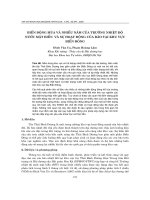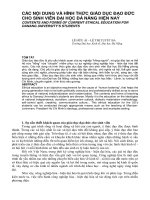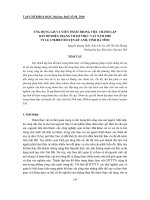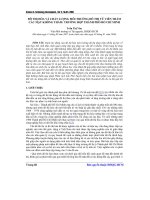Báo cáo nghiên cứu khoa học: "Tỷ lệ mắc và vi khuẩn gây bệnh nhiễm trùng đường tiết niệu ở trẻ em từ 2 tháng đến 6 tuổi trong một số lĩnh vực của Hải Phòng, Việt Nam trong năm 2008" pptx
Bạn đang xem bản rút gọn của tài liệu. Xem và tải ngay bản đầy đủ của tài liệu tại đây (109.93 KB, 8 trang )
385
JOURNAL OF SCIENCE, Hue University, N
0
61, 2010
THE INCIDENCE AND CAUSATIVE BACTERIA OF URINARY TRACT
INFECTION IN CHILDREN FROM 2 MONTHS TO 6 YEARS OLD
IN SOME AREAS OF HAI PHONG, VIETNAM IN 2008
Nguyen Ngoc Sang, Dang Van Chuc
Hai Phong Medical University
SUMMARY
This study was done to assess the incidence of urinary tract infection (UTI) in
children from 2 months to 6 years old in some areas of Haiphong Vietnam, and bacterial
causes and their antibiotic sensitivity on antibiogram from July to October 2007.
Method: This was a cross-sectional study including the screening of clean voiding
midstream samples in the morning for UTI. UTI was defined as the combination of both
leucocyturia (≥ 30/mm
3
urine) and bacteriuria (≥ 10
5
/ml urine). Results and
Conclusions: The common incidence rate was 2.8%, UTI affected more girls than boys
(3.3% vs. 2.2%). Causal bacteria was mainly negative gram and E. coli ranks first then
Proteus and Klebsiella. In addition, we found other bacteria such as Enterobacter and
Citrobacter. The bacteria was resistant to oral antibiotics but still sensitive to the third
generation of cephalosporines, amikacines and quinolone group.
Keyword: Urinary Tract Infection in children.
1. Introduction
Urinary Tract Infection (UTI) is a disease commonly found in children.
According to the WHO 3-8% of young girls and 1-3.0% of young boys have contracted
UTIs by the age of seven.
UTIs may cause kidney scars (15.1%), which results in dangerous complications
as the child grows older. These include anemia, hypertension (7-17%), prenatal
convulsion, puerperal eclampsia in girls as they grow up, kidney failure and final stage
kidney diseases. UTI causes considerable damage to the economy: The US government
has to spend US$ 1.6 billion per year on UTI. UTI bacteria have grown resistant to
antibiotics at a high level. We posed the questions: What is the rate of UTI researched in
hospitals and in the community?, is UTI bacteria the same as the UTI bacteria in
hospital and what is their sensitivity to antibiotics? In order to answer these questions,
we conducted this study with an aim to identify the UTI incidence among children aged
between two months and six years of age in a number of areas in Haiphong, Vietnam
386
and identify the causal bacteria and their sensitivity to antibiotics on an antibiogram.
2. Methods
2.1. Subject and research period
- All children between two months and six years of age in a number of areas in
Haiphong Vietnam.
- Research period: July 2007 through October 2007.
- UTI diagnosis criteria: urinary leukocyte ≥ 30/mm
3
and urinary bacteria ≥
10
5
/ml of urine.
2.2. Methods
- Research area: 3 selected districts, including Kien An (urban), Kien Thuy
(coastal) and Thuy Nguyen (rural). 9 selected wards/ communes include Nam Son,
Trang Minh and Van Dau (Kien An), Dai Ha, Tan Trao and Ngu Doan (Kien Thuy),
Phuc Le, Lap Le and Pha Le (Thuy Nguyen).
- Research design: Cross-sectional study.
- Sample size: calculated with the following formula:
2
2
2/1
1
d
pp
Zn
n: Sample size researched
Z
2
1-α/2
= 1.96 (reliability: 95%)
p = 0.04 ( UTI rate in children in a ward of Hong Bang district, Haiphong,
according to a study conducted by Nguyen Ngoc Sang et al 2005)
d: desired accuracy = (p*)
= 0.2
Applying the formula, we calculated that the number of children to be
researched is around 4610.
- Sampling: Sampling was done with the multi-stage method. In stage 1 districts
were deliberately selected. In stage 2 communes/ wards were randomly selected and in
stage 3 households were randomly selected.
- Data collection: Urine screening includes 3 steps:
Step 1. Urinary leukocyte screening.
A US made 10-parameter urine analyzing machine - Model TC 101-TECO was
used to screen urinary leukocytes. If there are ≥ 30 leukocytes per mm
3
then the urine
387
sample of this child was transferred in order to cultivate and divide bacteria. Midstream
urine was collected in the morning. The genital area was washed clean with soapy water
the night before and before the urine is obtained.
Step 2. Cultivating urine to identify urinary leukocytes: In accordance with the
process of the World Health Organization to detect and determine the name of bacteria.
Step 3. Make an antibiogram in order to determine the sensitivity of the bacteria
to the antibiotics: according to the Kirby - Bauer method.
- Data processing: SPSS software is used to enter and process the data. Calculate
the percentage, degree of sensitivity, intermediate and resistance of bacteria.
3. Results
- 4,631 children were urine screened, of whom 2,268 were boys (49%); 2,363
girls (51%); 1,603 rural children (34.6%); 1,568 coastal children (33.9%); 1,460 urban
children (31.5%). There were 618 babies between two and twelve months of age
(13.3%), 1,396 babies were between one and under three years of age (40,9%) and
2,120 were between 3 and 6 years old (45.8%).
- Genenal UTI rate: 128 out of 4,631 children were found as having both urinary
leukocytes and bacteria in accordance with UTI criteria, accounting for 2.8%, of which
the UTI rate among girls is 79/2,363 (3.3%) and boys is 49/2,268 (2.2%). The UTI rate
among the children aged between 2 months and under one year is 2.8% (17/618), those
aged 1 and under 3 years is 3.2% (61/1893) and those aged between 3 and 6 is 2.4%
(30/2120).
- The bacterium subdivided primarily is E.coli: 59/128 (46.09%), followed by
Proteus: 28/128 (21.87%), Klebsiella: 22/128 (17.18%), Enterobacter 13/128 (10.15%)
and Citrobacter: 6/128 (4.71%).
- The sensitivity of the bacteria to antibiotics on the antibiogram.
Table 1. Sensitivity of E. Coli to antibiotics on the antibiogram (59 samples)
Antibiotics
Resistance (R) Intermediate (I) Sensitivity (S)
n Rate % n Rate % n Rate %
Amikacine 18 30.5 4 6.8 37 62.7
Gentamicine 9 15.3 5 8.5 45 76.3
Augmentine 9 15.3 16 27.1 34 57.6
Amoxicilline 22 37.9 2 3.4 35 59.3
Ampicilline 34 57.6 17 28.8 8 13.6
388
Ceftriaxone 13 22.4 8 13.3 37 63.8
Cefotaxime 9 15.3 4 6.8 46 78.0
Nalidixic acid 10 16.9 17 28.8 32 54.2
Ciprofloxacine 15 25.4 12 20.3 32 54.2
Co-trimoxazole 29 49.2 10 16.9 20 33.9
Chloramphenicol 30 51.7 18 31.0 10 17.2
Remarks: E. coli is resistant to co-trimoxazol 49.2%, ampicilline 57.6%,
chloramphenicol 51.7% but still sensitive to amikacine 62.7%, gentamicine 76,3%,
augmentine 57.6%, amoxicilline 59.3%, ceftriaxone 63.8%, cefotaxime 78%, nalidixic
acid 54.2% and ciprofloxacine 54.2%.
Table 2. Sensitivity of Proteus to antibiotics on the antibiogram (28 samples)
Antibiotics
Resistance Intermediate Sensitivity
n Rate % n Rate % n Rate %
Amikacine 14 50.0 2 7.1 12 42.9
Gentamicine 9 32.1 3 10.7 16 57.1
Augmentine 2 7.1 5 17.9 21 75.0
Amoxicilline 6 21.4 2 7.1 20 71.4
Ampicilline 16 57.1 9 32.1 3 10.7
Ceftriaxone 11 39.3 7 25.0 10 35.7
Cefotaxime 3 10.7 0 0.0 25 89.3
Nalidixic acid 6 21.4 5 17.9 17 60.7
Ciprofloxacin 4 14.3 9 32.1 15 53.6
Co-trimoxazole 16 57.1 7 25.0 5 17.9
Chloramphenicol 15 53.6 11 39.3 2 7.1
Remarks: Proteus is sensitive to amoxicilline 71.4%, augmentine 75%,
gentamicine 57.1%, cefotaxime 89.3%, nalidixic acid 60.7% and ciprofloxacine 53.6%
but is resistant to amikacine 50%, co-trimoxazol 57.1%, ampicilline 57.1% and
chloramphenicol 53.6%.
389
Table 3. Sensitivity of Klebsiella to antibiotics on the antibiogram (22 samples).
Antibiotics
Resistance Intermediate Sensitivity
n Rate % n Rate % n Rate %
Amikacine 11 50.0 4 18.2 7 31.8
Gentamicine 5 22.7 4 18.2 13 59.1
Augmentine 2 9.1 2 9.1 18 81.8
Amoxicilline 2 9.1 1 4.5 19 86.4
Ampicilline 12 54.5 9 40.9 1 4.5
Ceftriaxone 4 18.2 7 31.8 11 50.0
Cefotaxime 0 0.0 2 9.1 20 90.9
Nalidixic acid 2 9.1 3 13.6 17 77.3
Ciprofloxacine 5 22.7 6 27.3 11 50.0
Co-trimoxazole 16 57.1 7 25.0 5 17.9
Chloramphenicol 10 45.5 10 45.5 2 9.1
Remarks: Klebsiella is resistant to amikacine 50%, co-trimoxazole 57.1%,
ampicilline 54.5%, and chloramphenicol 45.5% but is still sensitive to augmentine
81.1%, amoxicilline 86.4%, gentamicine 59.1%, ceftriaxone 50%, cefotaxime 90.9%,
nalidixic acid 77.3% and ciprofloxacine 50%.
Table 4. Sensitivity of Enterobacter to antibiotics on the antibiogram (13 samples)
Antibiotics
Resistance Intermediate Sensitivity
n Rate %
n Rate %
n Rate %
Amikacine 2 15.4 1 7.7 10 76.9
Gentamicine 5 38.5 2 15.4 6 46.2
Augmentine 5 38.5 1 7.7 7 53.8
Amoxicilline 7 53.8 0 0.0 6 46.2
Ampicilline 11 84.6 2 15.4 0 0.0
Ceftriaxone 4 30.8 5 38.5 4 30.8
Cefotaxime 4 30.8 1 7.7 8 61.3
Nalidixic acid 4 30.8 4 30.8 5 38.5
390
Ciprofloxacine 3 23.1 2 15.4 8 61.5
Co-trimoxazole 8 61.3 3 23.1 2 15.4
Chloramphenicol 8 61.5 5 38.5 0 0.0
Remarks: Enterobacter is resistant to most antibiotics used to treat UTI such as
amoxicilline 53.8%, co-tromoxazole 61.3%, ampicilline 84.6% and chloramphenicol
61.5% but is still sensitive to amikacine 76,9%, augmentine 53,8%, cefotaxime 61.3%
and ciprofloxacine 61.5%.
Table 5. Sensitivity of Citrobacter to antibiotics on the antibiogram (6 samples)
Antibiotics
Resistance Intermediate Sensitivity
n Rate %
n Rate %
n Rate %
Amikacine 0 0.0 0 0.0 6 100
Gentamicine 2 33.3 0 0.0 4 66.7
Augmentine 1 16.7 2 33.3 3 50.9
Amoxicilline 3 50.0 2 33.3 1 16.7
Ampicilline 4 66.7 1 16.7 1 16.7
Ceftriaxone 0 0.0 0 0.0 6 100
Cefotaxime 0 0.0 0 0.0 6 100
Nalidixic acid 3 50.0 1 16.7 2 33.3
Ciprofloxacine 0 0.0 1 16.7 5 83.3
Co-trimoxazole 3 50.0 2 33.3 1 16.7
Chloramphenicol 3 50.0 3 50.0 0 0.0
Remarks: Citrobacter is resistant to amoxicilline 50%, nalidixic acid 50%, co-
trimoxazole 50%, ampixicilline 66.7%, and chloramphenicol from 50%. Citrobacter, on
the contrary, is still sensitive to amikacine 100%, augmentine 50.9%, gentamicine
66.7%, ceftriaxone 100%, cefotaxime 100% and ciprofloxacine 83.3%.
4. Discussions
UTI rate among children aged between two months and six years in some areas
of Haiphong is 2.8%. This findings conform to that by Steven 2.8-4.2%, bigger than that
of Gram1.2% and Kikuo 0.28%.
By gender, we found that UTI rate in boys (2.2%) is lower than that in girls
(3.3%), a statistical difference. This findings are closer to those found in the study by
391
Gal, Steven and WHO : 1-3% boys and 6-8% girls contracted UTI respectively.
We found a distinct difference in UTI rate in the three age groups: 2 months and
under 1 years, 1 to less than 3 years and 3 to 6 years old. UTI rate by age group is 2.8%,
3.2% and 2.4% respectively. However, according to Steven the UTI rate is higher
among babies aged one than over one year of age.
All the causal bacteria we managed to subdivide are negative gram ones, with
E.coli ranked first, followed by Proteus, Klebsiella, Enterobactrer and Citrobacter. Our
findings conform to those obtained in the research by Arreguin, Prais and Steven. UTI
causing bacteria in the community are also similar to their counterparts in the hospital.
The sensitivity of bacteria to antibiotics on the antibiogram: Most antibiotics
orally used to treat UTI, such as co-trimoxazole, ampixiline, amoxiciline and
chloramphenicol are strongly resisted. This findings conform to that of Arreguin, Prais.
However, third generation antibiotics of the group cephalosporine, nalidixic acid,
ciprofloxacine are still sensitive. This findings conform to that of Tran Dinh Long at al.
5. Conclusions
UTI incidence rate in children aged between two months and six years in the
community is 2.8%, and the rate is higher in girls than in boys (3.3% vs. 2.2%).
The causal bacteria are mostly gram negative, firstly E.coli, followed by Proteus,
and then Klebsiella. In addition, there are some other bacteria such as Enterobacter and
Citrobacter.
The bacteria resisted against common antibiotics taken orally to treat UTI.
However, they are still sensitive to third generation cephalosporine, amikacine and
quinolone group.
REFERENCES
1. Tran Dinh Long at al. Clinical characteristics and some elements relating to
UTI in children, Medical Research Journal Book 35 No 2. (2005), 210-214.
2. Arreguin V et al. Microbiology of urinary tract infections in ambulatory patients.
Therapeutic options in times of high antibiotics resistance, Rev Invest Clin,
59(4): (2007), 239-45.
3. Foxman B. Epidemiology of urinary tract infection: incidence, morbidity, and
economic costs, Am J Med 8, (2002), 113.
4. Gal Finer et al. Pathogenesis of urinary tract infection with normal female
anatomy, The Lancet Infect Dis 4: (2004), 631-35.
392
5. Gram N et Coll. L’infections urinaires rcidivantes de l’enfant, Rev Maghr
PÐdiatr IX, 1, (1999), 3-14.
6. Kikuo Litaka et al. Screening for bateriuria in Japanese School children, Acta
Pediatr Jpn 32: (1990), 690-695.
7. Prais D et al. Bacterial susceptibiliy to oral antibiotics in community acquired
urinary tract infection, Arch Dis Child, 88: (2008), 215-218.
8. Steven L et al. Pediatric Urinary Tract Infection, Pediatr Clin N Am 53 (2006),
379-400.
9. World Health Organization. Urinary tract infections in infants and children in
developing countries in the contex of IMCI, (2005), 1-24.









